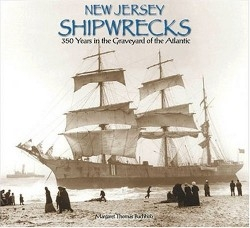New Jersey Shipwrecks
350 Years in the Graveyard of the Atlantic
The Jersey Shore has had the worst shipwreck record of any coastal region between Cape Cod and Cape Hatteras. According to the author, if all the remains of vessels embedded in the sands from Sandy Hook to Brigantine were laid end to end, they would form a continuous line.
Buchholz relates stories of heroism, harrowing tales of survival, and tragic accounts of failure, beginning in 1642. She points out that the passengers needed grit, stamina, a fierce determination to survive a shipwreck, and more than a little luck. The heroic lifesavers on the beach needed the same if they were to rescue any of the passengers. She also describes the role of wreckers, men hired by insurance companies for $1 or $2 a day to salvage goods found floating in the water. Perishable or damaged goods were sold at auction, usually on the beach.
On its first westerly crossing, in 1854, the German clipper ship New Era-filled with emigrants who had sold their livestock, farms, and homes, seeking a better life in the United States-was grounded about 150 yards off the coast during a gale. One survivor said, “We could see the bodies of many of our fellow passengers tossed about in raging waters; not so often alone, but in masses, as if when first launched into the waves they had clung to each other and so drowned.”
Buchholz, the author of Shore Chronicles: Diaries and Travelers Tales from the Jersey Shore 17641955, has drawn on numerous sources for this volume: books, articles, unpublished manuscripts, periodicals, and newspapers. Rather than giving just facts and figures, she adds a human touch with quotes from both survivors and rescuers: “Found him naked, his head, body, and limbs shockingly mangled,” and “The last sound I heard from his lips was motheras the sea washed him from the deck. I looked around and I was alone.”
Her description of the fire aboard the Morro Castle, an 11,520-ton luxury liner, is particularly vivid. Returning from Havana, Cuba, on September 8, 1934, 134 passengers drowned or burned to death while the ship was twenty miles off Asbury Park. Some panic-stricken passengers leaped into the ocean while others remained trapped in their cabins, with no possibility of escaping the inferno. Only a few lifeboats were launched into the choppy sea and several contained mostly stewards and crewmen.
For a few readers, these accounts of disaster may be a bit too disturbing, but Buchholz writes with a storytellers skill in recounting this fascinating segment of maritime history.
Reviewed by
George Cohen
Disclosure: This article is not an endorsement, but a review. The publisher of this book provided free copies of the book to have their book reviewed by a professional reviewer. No fee was paid by the publisher for this review. Foreword Reviews only recommends books that we love. Foreword Magazine, Inc. is disclosing this in accordance with the Federal Trade Commission’s 16 CFR, Part 255.

